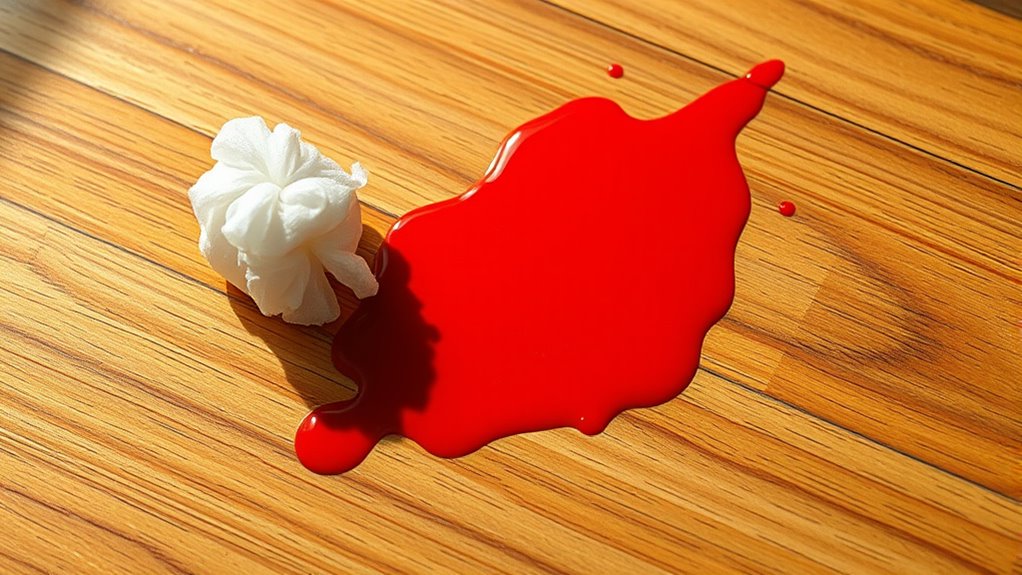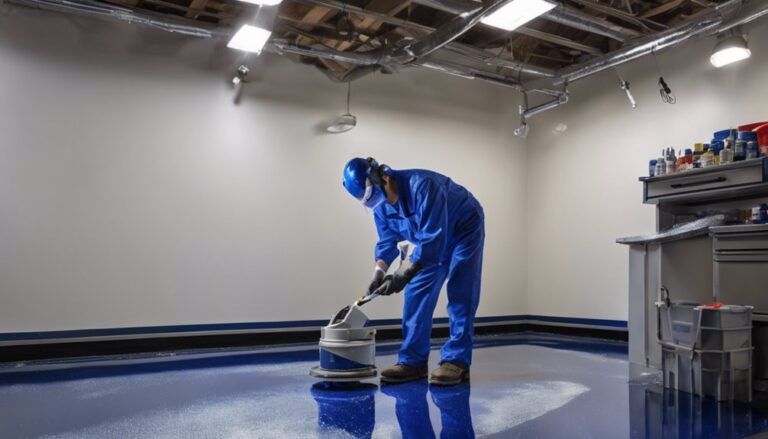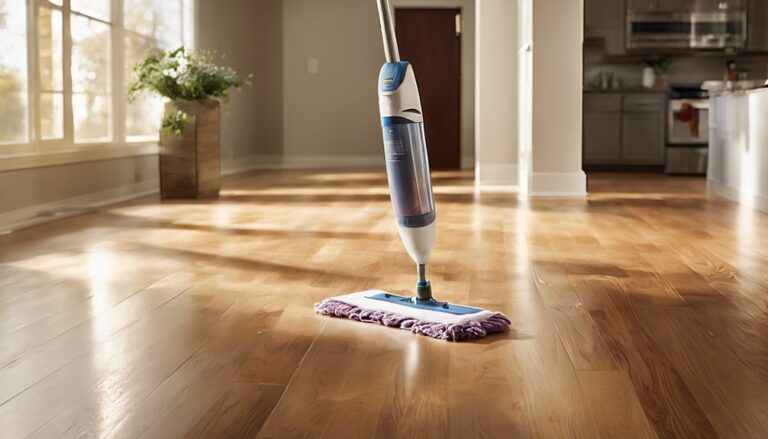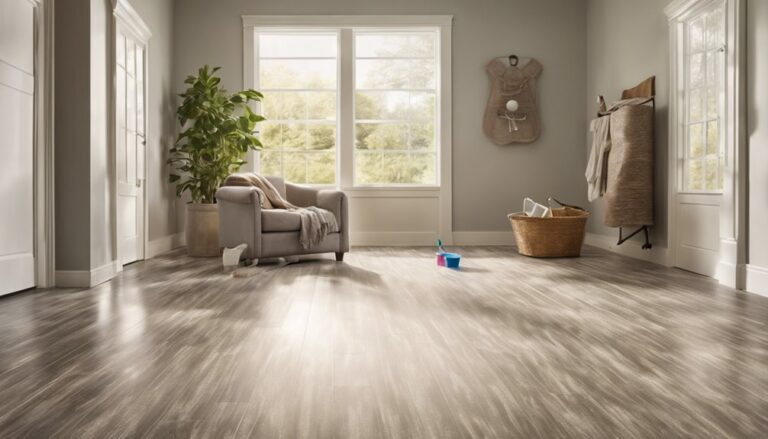To get nail polish off your wood floor, first identify the finish type to avoid damage. Test a non-acetone nail polish remover on a hidden spot to guarantee it won’t dull or discolor the wood. Gently dab the stain with the remover using a soft cloth, then wipe clean with mild soap and water. After removing the polish, restore the floor’s shine with wood polish or wax. There are also alternative methods and tips to protect your floor while cleaning.
Assessing the Type of Wood Floor Finish
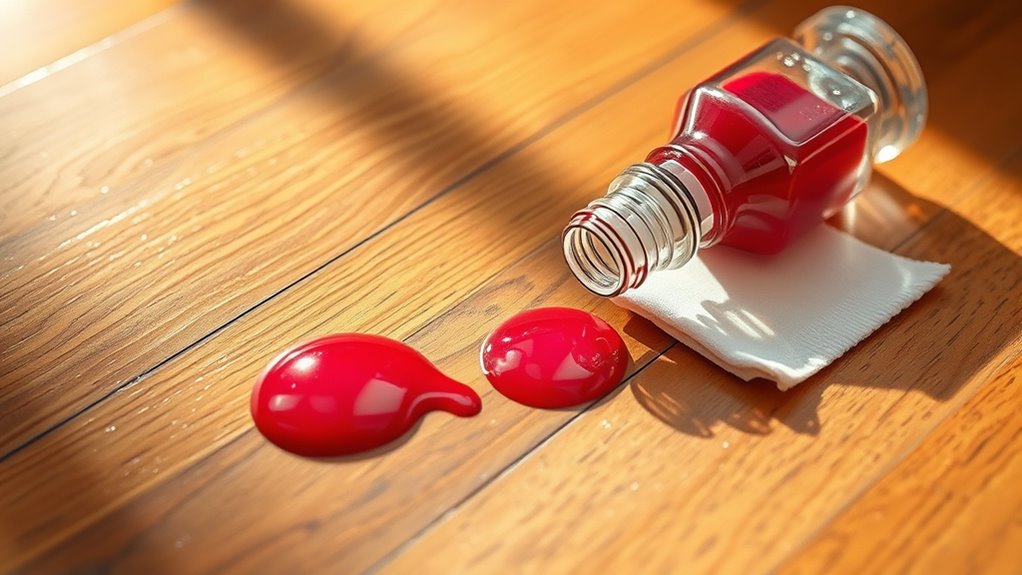
Before you begin removing nail polish, you need to identify the type of finish on your wood floor. Different wood floor types have finishes with varying durability, which affects how you should approach the stain. Common finishes include polyurethane, wax, shellac, and varnish. Polyurethane finishes are highly durable and resistant to stains, while wax finishes are softer and more vulnerable to damage. Shellac and varnish offer moderate durability but require careful handling. To assess your floor, test a small, inconspicuous area with water or a mild cleaner to see how the finish reacts. Knowing your finish’s durability helps you choose the safest removal method, preserving the floor’s integrity and ensuring you can confidently restore your wood floor without causing harm.
Gathering Necessary Supplies
To effectively remove nail polish from your wood floor, you’ll need a few essential supplies on hand. Having the right tools not only makes the process smoother but also protects your floor’s finish. Focus on gathering quality cleaning supplies that won’t cause damage.
Here’s what you should prepare:
- Nail polish remover – Opt for an acetone-free version to minimize harm to the wood finish.
- Soft cloths or cotton balls – These help apply the remover gently and absorb the polish without scratching.
- Mild soap and water – For cleaning the area after removal, ensuring no residue remains.
With these supplies ready, you’re set to tackle the nail polish stain efficiently while preserving your floor’s integrity.
Testing a Small Hidden Area
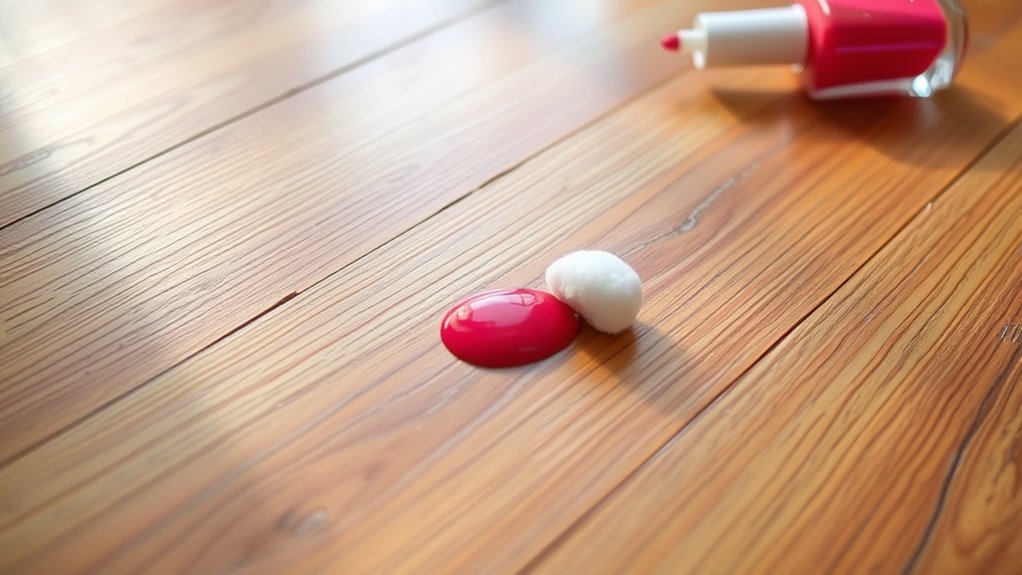
How should you guarantee your wood floor won’t be damaged by the nail polish remover? Start by selecting a hidden spot on the floor, such as under a piece of furniture or inside a closet. This test area acts as a safe zone where you can try the remover without risking visible damage. Apply a small amount of the chosen product to a cloth, then gently dab it onto the hidden spot. Wait a few minutes to observe any discoloration, dullness, or finish damage. If the wood’s appearance remains unchanged, you can confidently proceed with treating the nail polish stain. Testing this small hidden area confirms your floor’s integrity stays intact, allowing you the freedom to clean effectively without unexpected harm.
Using Non-Acetone Nail Polish Remover
Once you’ve guaranteed the nail polish remover won’t harm your floor, you can move on to using a non-acetone nail polish remover. This option offers safer breakdown of polish without harsh chemicals, showcasing non acetone effectiveness on delicate wood surfaces. Here’s how to proceed:
- Apply a small amount of non-acetone remover to a soft cloth or cotton ball.
- Gently dab the stained area, avoiding excess liquid that could damage the wood.
- Wipe the area clean with a damp cloth immediately after the polish starts dissolving.
Non-acetone removers serve as excellent nail polish alternatives, balancing efficiency with floor safety. Using this method lets you remove polish effectively while preserving your wood’s finish, giving you freedom from stubborn stains without risk.
Applying Rubbing Alcohol or Isopropyl Alcohol
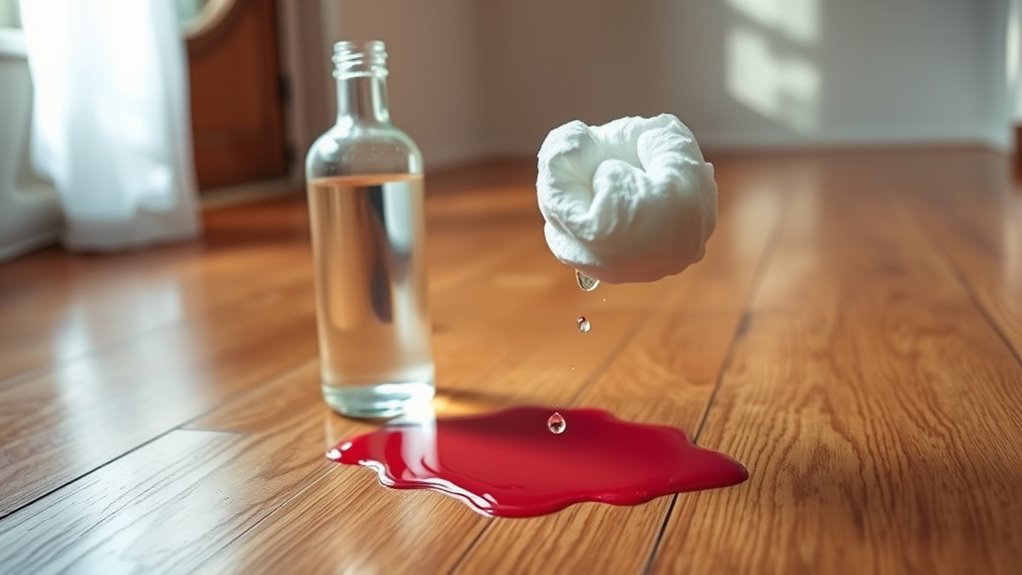
Although rubbing alcohol can be stronger than non-acetone remover, it’s effective at breaking down nail polish without causing major damage if used carefully. To harness the rubbing alcohol benefits, pour a small amount of isopropyl alcohol onto a clean cloth. Gently dab the stained area—avoid soaking the wood to prevent damage. The isopropyl alcohol effectiveness lies in its ability to dissolve polish quickly, making it easier to wipe away. Work in small sections, applying light pressure and reapplying alcohol as needed. Once the polish softens, wipe it off with a dry cloth. Finally, clean the area with a damp cloth and dry thoroughly to restore the wood’s natural finish. This method offers a balance of strength and safety for your 床材.
Trying Baking Soda and Water Paste
One effective way to tackle nail polish stains on wood floors is by using a baking soda and water paste. This method leverages the baking soda benefits, including its gentle abrasiveness and natural cleaning power, making it safe for wood surfaces.
Using a baking soda and water paste gently removes nail polish stains while protecting wood floor finishes.
Here’s how to use the water paste to remove the stain:
- Mix baking soda with just enough water to create a thick paste.
- Apply the paste directly onto the nail polish stain and let it sit for 10-15 minutes.
- Gently scrub the area with a soft cloth or sponge, then wipe clean with a damp cloth.
This approach allows you to clean without harsh chemicals, maintaining your floor’s finish while freeing it from stubborn polish marks.
Using Vinegar and Olive Oil Solution
If the baking soda paste doesn’t fully lift the nail polish, you can try a vinegar and olive oil solution. Vinegar benefits include its mild acidity, which helps break down the polish without harming your wood floor’s finish. Mix equal parts white vinegar and olive oil, then apply the blend to the stained area with a soft cloth. The olive oil not only conditions the wood but also aids in loosening the polish gently. Let it sit for about 10 minutes, allowing the solution to penetrate. Afterward, wipe the area with a clean cloth, rubbing gently in circular motions. This method gives you a natural, effective way to remove nail polish while preserving your floor’s integrity and maintaining your freedom from harsh chemicals.
Gently Scraping Off Dried Nail Polish
Start by carefully scraping off the dried nail polish using a plastic scraper or an old credit card to avoid damaging your wood floor. Choose gentle scraping tools designed to protect the surface. Here’s how to proceed:
- Hold the scraper at a low angle to the floor, applying minimal pressure to lift the polish without scratching.
- Work slowly to loosen the polish residue, focusing on small sections to prevent spreading or embedding it further.
- Collect the lifted polish with a soft cloth or paper towel, disposing of it carefully to avoid re-depositing.
This method lets you remove most of the dried nail polish effectively while preserving your floor’s integrity. Stay patient and precise—rushing can cause damage and make cleanup harder.
Cleaning and Polishing the Wood Floor After Removal
Once you’ve removed the nail polish residue, you’ll want to clean the area thoroughly to eliminate any remaining stains or cleaning agents. Start with a gentle cleaning technique: use a soft cloth dampened with a mixture of warm water and mild dish soap to wipe the spot. Avoid harsh chemicals that could damage the wood finish. After drying the area, assess for dullness or unevenness caused by the removal. To restore the shine, apply appropriate polishing methods—use a high-quality wood floor polish or wax, following the product instructions carefully. Apply it evenly with a microfiber cloth or applicator pad, then buff the surface gently. These steps guarantee your wood floor looks fresh and protected, letting you enjoy a clean, polished surface without restrictions.

